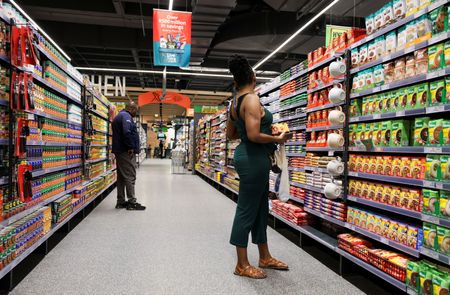By Kopano Gumbi and Tannur Anders
PRETORIA (Reuters) -South Africa’s economic growth picked up in the second quarter, supported by higher consumer spending and power availability, but output declines in agriculture, mining and transport meant growth was slightly weaker than expected.
Gross domestic product (GDP) expanded 0.4% in quarter-on-quarter seasonally-adjusted terms in April to June, below the 0.5% growth forecast by economists polled by Reuters but above the first quarter’s flat output.
South Africa’s top statistics official said it was too early to say whether the coalition government that emerged after May’s election had contributed to the improved second-quarter performance, since President Cyril Ramaphosa was only sworn in for a second term in mid-June.
“Even in the next quarter, it would be too early to tell about the effects of the government of national unity,” Statistician-General Risenga Maluleke told reporters.
Seven of the 10 sectors tracked by Statistics South Africa registered growth in the latest three-month period, as the economy benefited from an unbroken stretch without power cuts for the first time in years.
But economists said lingering bottlenecks at ports and on the freight rail network and weak global demand remained a drag.
“It’s a big step forward to not have power disruptions, but (we’re) not there yet in terms of all the other constraints,” said Lisette IJssel de Schepper, chief economist at the Bureau for Economic Research (BER).
After the marked improvement in power utility Eskom’s performance this year, inefficiencies at state logistics group Transnet are among the biggest unresolved issues.
FASTER GROWTH AHEAD?
South African factory activity also slumped in August, indicating that business conditions remain highly volatile in key sectors.
IJssel de Schepper said growth could start to pick up from the fourth quarter.
One reason is a government pension policy reform that came into effect on Sept. 1 and will allow fund members to withdraw some of their savings before retirement age.
The central bank estimates withdrawals could be between 40 billion rand and 100 billion rand ($2.2 billion and $5.6 billion) by the end of the year, boosting household consumption spending and GDP growth.
Another factor is that the central bank is expected to start cutting interest rates from this month for the first time in four years.
The BER forecasts 2.2% growth in 2025, up from 1% this year, but it says for that to be sustained there needs to be progress with reforms to enhance the country’s growth potential.
($1 = 17.9700 rand)
(Reporting by Kopano Gumbi and Tannur AndersEditing by Alexander Winning)





